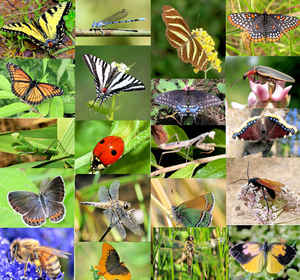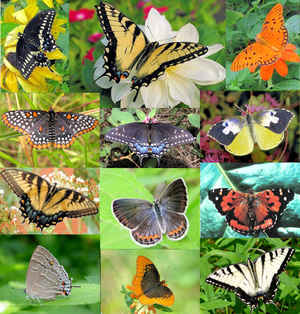
Mississippi Symbols
Mississippi State Butterfly
Spicebush Swallowtail Butterfly

(Pterourus troilus )
Adopted in 1991.
The Spicebush Swallowtail, (Pterourus troilus,) was designated the State Butterfly of Mississippi in 1991. Chapter 315, General Laws of Mississippi of 1991. The spicebush swallowtail butterfly is a large, dark swallowtail. It is one of our most beautiful and interesting swallowtails. All developmental stages are great examples of adaptive coloration.
Mississippi State Butterfly
Spicebush Swallowtail

The Spicebush Swallowtail (Papilio troilus) is a common black swallowtail butterfly found in North America, also known as the Green-Clouded butterfly. It has two subspecies, Papilio troilus troilus and Papilio troilus ilioneus, the latter found mainly in the Florida peninsula. The spicebush swallowtail derives its name from its most common host plant, the spicebush, members of the genus Lindera.
The family to which Spicebush Swallowtails belong, Papilionidae, or swallowtails, include the largest butterflies in the world. The swallowtails are unique in that even while feeding, they continue to flutter their wings. Unlike other swallowtail butterflies, Spicebushes fly low to the ground instead of at great heights.
Characteristics of the Spicebush Swallowtail
The wingspan of the adult Spicebush Swallowtail is roughly 4 inches. The upper side of forewing is mostly black with ivory spots along the edge,
while the upper surface of hindwing has orange spots on the edge and some blue (female) or blue-green (male) scales. The underside of hindwing is pale
green with a few spots. The adults are believed to be part of a mimicry complex that includes the Black Swallowtail (Papilio polyxenes), Pipevine
Swallowtail (Battus philenor), Red-Spotted Purple (Limentis arthemis astyanax), and black form females of the Tiger Swallowtail (Papilio
glaucus).
Spicebush swallowtails are mainly found in the eastern states from southern Canada south to Florida and west to Oklahoma and central Texas. They have
been reported in Cuba as well. Adults prefer wooded areas and swamps, fields, roadsides, and parks, and feed on nectar from Japanese honeysuckle, thistles,
jewelweed, azalea, dogbane, milkweed, sweet pepper bush, and mimosa. Males roam in woods, along roads and woodland edges to find suitable females as
mates. Females lay eggs singly on the underside of leaves of sassafras and spicebush. Caterpillars form a shelter by folding leaves over themselves
and tying them with silk. They feed nocturnally. Caterpillars have two false eyes and will turn bright yellow later in their development.
Mississippi Law
The law designating the spicebush swallowtail as the official Mississippi state butterfly is found in the Mississippi Code, Title 3, Chapter 3.
TITLE 3. STATE SOVEREIGNTY, JURISTICTION AND HOLIDAYS.
CHAPTER 3. STATE BOUNDARIES, HOLIDAYS, AND STATE EMBLEMS.
§ 3-3-33. State butterfly.
The spicebush swallowtail (Pterourus troilus) is hereby designated the state butterfly of Mississippi.
Sources: Laws, 1991, ch. 315, ? 1, eff from and after July 1, 1991.
Taxonomic Hierarchy: Spicebush Swallowtail
Kingdom: Animalia (Animals)
Phylum: Arthropoda (Arthropods)
Subphylum; Hexapoda (Hexapods)
Class: Insecta (Insects)
Order; Lepidoptera (Butterflies and Moths)
Superfamily: Papilionoidea (Butterflies and Skippers)
Family: Papilionidae (Swallowtails, Parnassians)
Subfamily: Papilioninae
Tribe: Troidini (Birdwings, Cattlehearts and Aristolochia Swallowtails)
Genus: Battus
Species: philenor (Pipevine Swallowtail - Hodges#4157)
Butterflies, and Bugs







